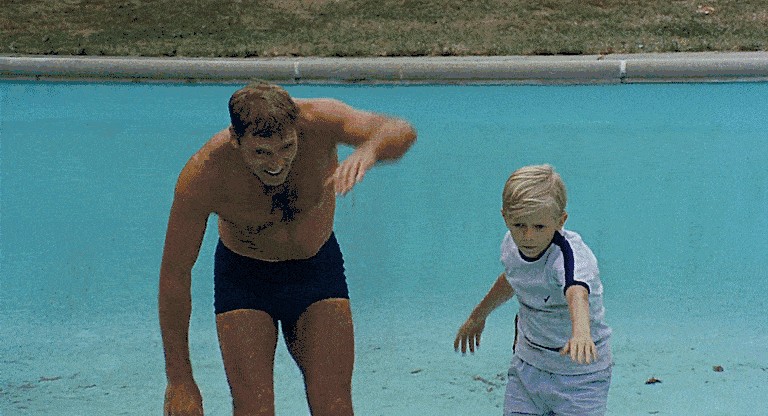
Alphaville
There’s no love to be found in this noir-ish sci-fi from French New Wave legend Jean-Luc Godard, which is widely considered one of his last accessible works — although, in true Godard style, it remains far from a conventional narrative film. American secret agent Lemmy Caution (Eddie Constantine) is undercover and on a mission to assassinate both the human and robotic rulers of the loveless, Orwellian nightmare world of Alphaville. This is a city runs on a strict code of pure logic; anyone caught displaying emotion, whether happy or sad, will earn themselves one of the death sentences frequently meted out by Alpha 60, the city’s despotic computer overlord.
The piscine is where Alphaville’s firing squad is based, and it’s where this scene is set. We watch as “irrational” criminals, guilty of such crimes as mourning their wives, take turns standing on a diving board on which they’ll deliver their final words. The echoey acoustics of the pool room give their impassioned speeches and the shots that follow a distinctly eerie tone, an effect that is amplified by the bizarre sight of lithe synchronized swimmers diving in to retrieve the bodies seconds after they hit the water. Godard’s right-hand cinematographer Raoul Coutard captures the whole horror in quotidian black-and-white, heightening Alphaville’s uncomfortable sense of contemporaneity and forging a lasting cinematic link between the sight and sounds of an indoor community pool and the terrible spectacle of mass execution.
Poltergeist
Pools have been a staple of unsettling movies like Alphaville and Cat People for decades, but it wasn’t until Poltergeist’s stomach-churning vat of corpses that their potential for horror was fully realized. In a scene later referenced by Jennifer’s Body and Dario Argento’s Phenomena, a mother terrorized by evil spirits is dragged into a pool full of putrefying corpses (which were, incidentally, real). JoBeth Williams’ character writhes through the mud as she tries to escape and save her children, but the cadavers and coffins keep erupting out of the sludge to meet her. More than just a reminder not to build houses on cemeteries, Poltergeist pioneered the idea of the pool as a homicidal space, giving rise to the deadly waters of This House Possessed, The Legacy and 12 Feet Deep.
Romeo + Juliet
Pools don’t always have to be terrifying, though. The titular lovers in Baz Luhrmann’s 1996 Shakespeare reimagining are tied to the romantic leitmotif of water from the moment they meet – they first lock eyes from either side of a glittering aquarium – so it’s apt that the two should reunite in a pool, rather than the traditional balcony, for their first meeting alone.
Thrust into the water together after Romeo (Leonardo DiCaprio) takes Juliet (Clare Danes) by surprise, the young lovers are instantly granted a greater level of intimacy than they’ve yet had: all physical barriers between them are erased, and with them, the need to adhere to decorum. This total vulnerability in the water emphasizes the emotional directness of their infamous exchange, an effect intensified by the camera being at water-level.
Where A Bigger Splash’s pool scene made use of its night-time setting to disorient viewers, Romeo + Juliet plays on the inherent romance of the dark, as the swooning strains of Craig Armstrong’s score radiate a warmth matched by gentle lapping sounds and the softly rippling reflections of the water on the pair’s faces. The whole scene has a tender sensuality about it – an atmosphere only broken when the water briefly becomes Romeo’s shelter from Juliet’s guards – especially when the star-crossed lovers plunge back underwater for a kiss that inspired similar smooches in The Beach and Whip It.
I am Cuba
Never has black and white looked so vibrant. This gorgeous opening scene from a relatively unknown Soviet-Cuban 1964 production so wowed Paul Thomas Anderson that it formed the main inspiration for his own pool scene extraordinaire in Boogie Nights.
Beginning on the rooftop of a Havana hotel, cameraman Alexander Calzetti snakes through a beauty pageant walk, scales down multiple stories and plunges his lens underwater in one impossibly acrobatic single take. Indeed, the sequence was so radical that I Am Cuba’s filmmakers had to invent new technology to make it possible.
But its innovative methods aren’t the real crux of this scene’s charm. With a lively swing score and the shores of the Caribbean lying just within sight, I Am Cuba’s opening moments completely counter the dominant image associated with post-revolutionary Cuba. Tuxedoed waiters serve drinks to guests garbed in prints so vivid you’re prone to forgetting this isn’t shot in color, with that effect being boosted ten-fold when a bikini-clad woman leads the camera into the pool and under the water. Remarkably, Western audiences only first witnessed director Mikhail Kalatozov and cinematographer Sergei Urusevsky’s dazzling work thirty years after it was shot, that being thanks to the efforts of US film festival programmers and eminent patrons like Martin Scorsese and Francis Ford Coppola.
The Swimmer

Speaking of under-seen classics, Frank and Eleanor Perry‘s The Swimmer is overflowing with pool scenes. Having decided to swim his way home via a “river” of backyard pools, suburban stud Ned Merrill (Burt Lancaster) glides across serene waters in mansion backyards, fights his way through over-crowded community pools and otherwise swims through every watery square-inch his affluent neighborhood can offer.
There is one moment that stands out amongst the rest for its metaphorical implications, though: the scene in which the deluded Ned delivers a spur-of-the-moment swimming lesson to a young boy in an empty pool. The two front crawl and breaststroke across the expanse of dry blue tiling, kidding themselves that they’re really doing it. Perfectly encapsulating the way Ned has been drained of all sense of reality, this allegorical scene lays bare his total reliance on fantasy to get through the day: as he puts it himself, “If you make-believe hard enough that something is true, then it is true for you.”
(For more Swimmer-themed action, try La Controfigura, a film about a film in which an Italian body double re-traces Ned’s quest across the pools of Marrakech.)
Related Topics: billy wilder, Foreign Film, Horror, Jean-Luc Godard, jonathan glazer, Luca Guadagnino, Summer, The Graduate, Update The Lists

